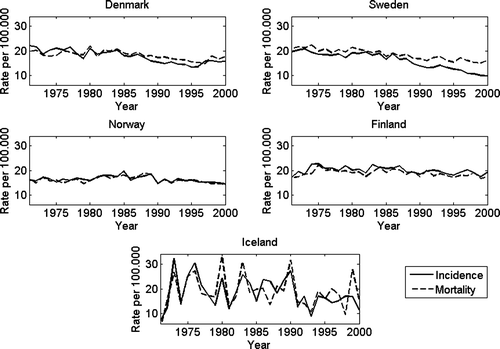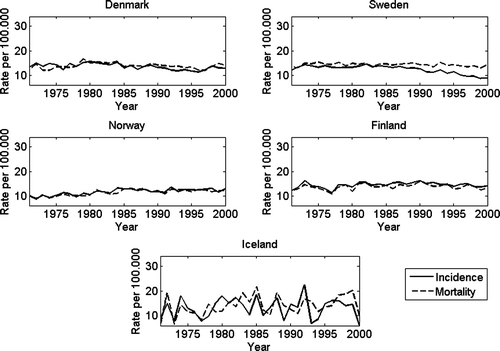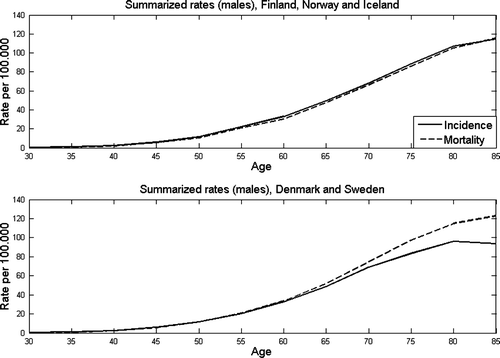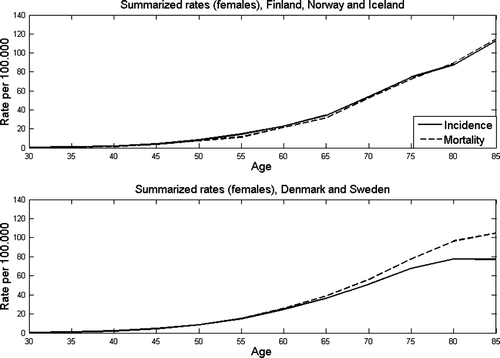Abstract
Pancreatic cancer (PC) is the sixth most frequent cause of death from cancer in Europe in men as well as women. Apart from smoking, little is known about the aetiology of PC. This study examines trends in incidence and mortality of PC in Denmark, Finland, Iceland, Norway, and Sweden from 1971 to 2000, using the database NORDCAN, with data on incident cases of PC derived from the national cancer registries and data on deaths from PC from the national registries on causes of death. The analysis included 91 842 incident cases and 96 430 deaths from PC in a total population of about 23 million. The mean age at diagnosis was 69 years for males in the Nordic countries for the period 1996–2000 and 72 years for females. Using the age-specific rates from year 2000 to calculate the cumulative risk, 8.4 of 1 000 Nordic men and 6.7 of 1 000 Nordic women will develop PC before the age of 75 years. Over the past 30 years incidence and mortality rates have been decreasing in males and remained stable without any particular trend in females whether examined by calendar time or birth cohort. However, there are considerable difficulties in obtaining true estimates of the incidence and mortality from PC, since less than 60% of incident cases are verified histologically and autopsy rates have decreased over time.
During the last two decades, the age standardized (world) incidence rate of pancreatic cancer (PC) has remained stable with an estimate of 9–10 cases per 100 000 in Europe and North America Citation[1]. PC is more frequent in developed regions like Northern America, Europe and Australia than in less developed regions, e.g. in Africa and Asia Citation[2]. The incidence of PC increases with age, but apart from this little is known about the aetiology. Studies have examined life-style factors such as smoking Citation[3–5], depression Citation[6], and obesity Citation[7] and health related factors such as diabetes mellitus Citation[8], Citation[9] but no clear pattern has emerged. Smoking is the only generally accepted risk factor for developing PC Citation[3–5].
PC is the sixth most frequent cause of death from cancer in Europe year 2004 in men as well as women Citation[10] and only 15% survive the first year after diagnosis Citation[11]. The reason for this may relate to the fact that 85% of cases are diagnosed in a stage too advanced for surgery Citation[12]. For operable patients, a pancreatic resection may improve 5-year survival to 20–35% Citation[13], Citation[14].
This study reports data on incidence and mortality of PC from 1971 to 2000 in the Nordic countries where population-based cancer registration has been in service for up to 60 years.
Material and methods
National cancer registries were established in Denmark in 1942, in Finland in 1952, in Iceland in 1954, in Norway in 1951, and in Sweden in 1958 with the purpose of registering all cases of cancer occurring in the populations Citation[15]. Since the 1950's, the national cancer registries in the Nordic countries have been collaborating and exchanging experience and knowledge. In 2001, the NORDCAN Citation[16] program was developed enabling access to cancer statistics for the Nordic countries with a total population of more than 23 million. This database contains information about cancer incidence and mortality of 40 major types of cancer in the period 1971–2000 and is updated on a yearly basis. The NORDCAN package is divided into two components: a database, which contains the quantitative data, and a program, which is used to visualize the data in a graphical or tabular representation. In NORDCAN, data on incident cases of cancer are obtained from the national cancer registries, and data on deaths of cancer from the national registries on causes of death. Based on the detailed ICD coding in each registry, data are transformed to comparable categories used in NORDCAN. Mortality data are transformed likewise.
Rates of PC were calculated as average annual rates per 100 000 person-years. Age-standardization was performed using the Nordic standard population, the Nordic population in 2000. This standard population was preferred due to the large number of elderly persons in the Nordic countries compared to the World Standard Population. Age-specific rates were subdivided into following age-groups 0–4, 5–9 … 85+. The mean age at diagnosis was calculated as a weighted average. Cumulative risks were calculated for the age span of 0–74 years.
Results
From 1971 to 2000 there was a total of 91 842 incident cases and 96 430 deaths from PC in the Nordic countries. shows the number of incident cases and deaths from PC for each country in the beginning of the study period (1971) and at the end (2000) and the total for 1971–2000.
Table I. Number of incident cases and deaths of pancreatic cancer in the Nordic countries, 1971–2000.
Adjusting changes in age and population size, shows that the incidence rates among men were highest in Iceland but fluctuated much over the time period studied, reflecting the small population of Iceland (about 270 000). In Denmark and Sweden, there was a trend of decreasing incidence from 1971 to 2000 though a slight increase in incidence was noted in Denmark from 1995 to 2000. In Norway the incidence rates were quite stable fom 1971 to 1989 but thereafter a slight decrease was observed. In Finland no clear changes were observed in the incidence trend over the period. The pattern for PC mortality was similar to that for incidence though it should be noted that mortality rates were higher than incidence rates in Sweden and in Denmark. Incidence and mortality rates were lower in women than in men, but with no clear trend with time (). As a summary estimate, we calculated the cumulative risk of developing PC from age 0–74 years in the Nordic countries in year 2000 to be 0.84% for males and for females 0.67%, i.e. 8.4 of 1 000 Nordic men and 6.7 of 1 000 Nordic women will develop PC before the age of 75 years.
Figure 1. Trends in pancreatic cancer incidence and mortality among males in the Nordic countries (1971–2000). Adjusted to the Nordic 2000 standard population All ages.

Figure 2. Trends in pancreatic cancer incidence and mortality among females in the Nordic countries (1971–2000). Adjusted to the Nordic 2000 standard population All ages.

Incidence as well as mortality rates of PC in the Nordic population increased steadily with age as illustrated in and for 1996–2000. The age-specific pattern was similar for incidence and mortality in Iceland, Finland, and Norway, but in Denmark and Sweden, lower incidence than mortality rates were observed for those aged 70 years or more, and (bottom row).
Figure 3. Age specific incidence and mortality rates of pancreatic cancer in the Nordic countries among males (1996–2000).

Figure 4. Age specific incidence and mortality rates of pancreatic cancer in the Nordic countries among females (1996–2000).

To evaluate the simultaneous effects of trends in age and calender time, we examined the incidence rates by birth cohorts from 1896 to 1956 (data not shown). The trends were similar for men and women. In Denmark and Sweden, there was a trend of decreasing incidence by birth cohort, while in Finland, Iceland and Norway no clear pattern was observed.
We calculated the mean age at diagnosis for all males in the Nordic countries for the period 1996–2000 to be 69 years (95% Confidence Interval (CI): 67–70) and for all females in the same period to be 72 years (95% CI: 70–74).
Discussion
The present study shows that in the Nordic countries, PC is a disease of elderly people with mean ages at diagnosis of 69 years for men and 72 years for women. The risk of developing PC before age 75 years was slightly higher in the Nordic countries than corresponding estimates from of Canada, Ireland, The Netherlands, England, Scotland and New Zealand with ranges of cumulative risks of 0.73–0.86% for males and 0.30–0.65% for females Citation[2].
Our results from the Nordic countries demonstrate that over the past 30 years incidence and mortality rates have been decreasing in males and remained stable without any particular trend in females whether examined by calendar time or birth cohort. This is remarkable considering the changes in life-style, in particular smoking habits, which have occurred over the past 50 years. It emphasizes our lack of understanding of the aetiology of PC.
The strength of the present study is that it is entirely population based using the data from NORDCAN which is a novel data acquisition method in epidemiologic studies. However, PC is not an easy disease to study. The most valid evidence of a diagnosis of PC is a histological sample, but due to the anatomical position of the pancreas, biopsies are often difficult to obtain. In 2000, only 61% of incident cases of PC were histologically verified in Denmark Citation[17] and about 53% in Norway Citation[18], thus leaving PC as one of the most poorly histologically verified main cancers.
Since the clinical symptoms of PC are often unspecific, PC may be diagnosed by autopsy only. In Denmark, the number of autopsies was decreasing from 28% of all deaths in 1985 to 7% in 2000 Citation[19] and similar figures have been reported from Sweden Citation[20]. However, death certificates may be issued without a proper diagnostic procedure so that “an abdominal tumour” may be registered as PC. This may lead to an “overdiagnosis” of PC in death certificates. These facts may have led to a decrease in the registered incidence and mortality from PC, i.e. an underestimation of the true rates.
The cancer registries in Denmark, Finland, Iceland and Norway use information on cause of death from death certificates to update information on incident cancers and to validate the diagnosis of cancer, i.e. a death registered as caused by PC will be registered as an incident case of PC and information sought from hospital departments to verify and validate this diagnosis. This procedure has not been used in Sweden Citation[21] and may explain why the number of deaths from PC exceeded the number of incident cases, particularly from 1991–2000. The discrepancy can also be seen in the analysis of age specific incidence and mortality rates. According to the 2000 annual report from the Swedish Cancer Registry, there were about 2 300 persons in the Swedish Cause of Death Registry with different types of cancer stated as the underlying cause of death which were not on file in the Cancer Registry 1958–2000 Citation[22]. In proportion to the number of cases per year, PC was the most common cancer. Considering that the pattern of age specific mortality rates in Sweden were similar to those of the other Nordic countries and the poor survival after PC Citation[10], we believe that the age specific mortality rates in Sweden are good estimates of the true incidence in Sweden.
In conclusion, the present study demonstrates that even in countries like the Nordic with a long tradition of population based cancer registration, there are considerable difficulties in obtaining true estimates of the incidence and mortality from PC. It is a disease with high mortality and little is known about the aetiology. More effort should be spent on modern methods of a biological characterization of this disease, earlier diagnosis, and application of new therapeutical stategies.
References
- Rosewicz S, Wiedenmann B. Pancreatic carcinoma. Lancet 1997; 349: 485–9
- Parkin DM, Whelan S, Ferlay J, Storm HH. Cancer incidence in five continents, Vol. I to VIII. IARC CancerBase 2005; No. 7.
- Silverman DT, Dunn JA, Hoover RN, Schiffman M, Lillemoe KD, Schoenberg JB, et al. Cigarette smoking and pancreas cancer: A case-control study based on direct interviews. J Natl Cancer Inst 1994; 86: 1510–6
- Fuchs CS, Colditz GA, Stampfer MJ, Giovannucci EL, Hunter DJ, Rimm EB, et al. A prospective study of cigarette smoking and the risk of pancreatic cancer. Arch Intern Med 1996; 156: 2255–60
- IARC Monographs on the Evaluation of Carcinogenic Risks to Humans, Volume 83, Tobacco Smoke and Involuntary Smoking, IARC, Lyon 2004.
- Carney CP, Jones L, Woolson RF, Noyes R, Doebbeling BN. Relationship between depression and pancreatic cancer in the general population. Psychosom Med 2003; 65: 884–8
- Larsson SC, Permert J, Håkansson N, Næslund I, Bergkvist L, Wolk A. Overall obesity, abdominal adiposity, diabetes and cigarette smoking in relation to the risk of pancreatic cancer in two Swedish population-based cohorts. Br J Cancer 2005; 93: 1310–5
- Calle EE, Murphy TK, Rodriguez C, Thun MJ, Heath CW. Diabetes mellitus and pancreatic cancer mortality in a prospective cohort of United States adults. Cancer Causes Control 1998; 9: 403–10
- Huxley R, Ansary-Moghaddam A, Berrington de González A, Barzi1 F, Woodward M. Type-II diabetes and pancreatic cancer: A meta-analysis of 36 Studies. Br J Cancer 2005; 92: 2076–83
- Boyle P, Ferlay J. Cancer incidence and mortality in Europe, 2004. Ann Oncol 2005; 16: 481–8
- Santi M, Aareleid T, Berrino F, Lasota MB, Carli PM, Faivre J, et al. EUROCARE-3: survival of cancer patients diagnosed 1990–94 – results and commentary. Ann Oncol 2003; 14(Suppl. 5)v61–v118
- DiMagno EP, Reber HA, Tempero MA. AGA technical review on the epidemiology, diagnosis, and treatment of pancreatic ductal adenocarcinoma. Gastroenterology 1999; 117: 1464–84
- Burcharth F, Olsen SD, Trillingsgaard J, Federspiel B, Moesgaard F, Struckmann JR. Pancreaticoduodenectomy for periampullary cancer in patients more than 70 years of age. Hepatogastroenterology 2001; 48: 1149–52
- Sener SF, Fremgen A, Menck HR, Winchester DP. Pancreatic cancer: A report of treatment and survival trends for 100,313 patients diagnosed from 1985–1995, using the National Cancer Database. J Am Coll Surg 1999; 189: 1–7
- Jensen OM, Carstensen B, Glattre E, Malker B, Pukkala E, Tulinius H. Atlas of cancer incidence in the Nordic countries. Nordic Cancer Union. 1988
- Engholm G, Storm H, Ferlay J, Christensen N, Langmark F, Ólafsdóttir E, et al. NORDCAN: Cancer incidence and mortality in the nordic countries, Version 2.1., Danish Cancer Society 2005. http://www.ancr.nu/nordcan.asp.
- Cancer incidence 2000. National Board of Health, Denmark 2004.
- Cancer incidence in Norway 2000. Cancer Registery of Norway Institute of Population-based Cancer Research 2002.
- The Danish cause of death register 2001. National Board of Health, Denmark 2005.
- Eriksson L, Sundstrom C. Decreasing autopsy rate in Sweden reflects changing attitudes among clinicians. Qual Assur Health Care 1993; 5: 319–23
- Lund EM, Clemmensen IH, Storm HH, Engholm G. Survey of Nordic Cancer Registries. Danish Cancer Society 2000. http://www.ancr.nu/survey.asp.
- Cancer incidence in Sweden 2000. Socialstyrelsen 2002.
